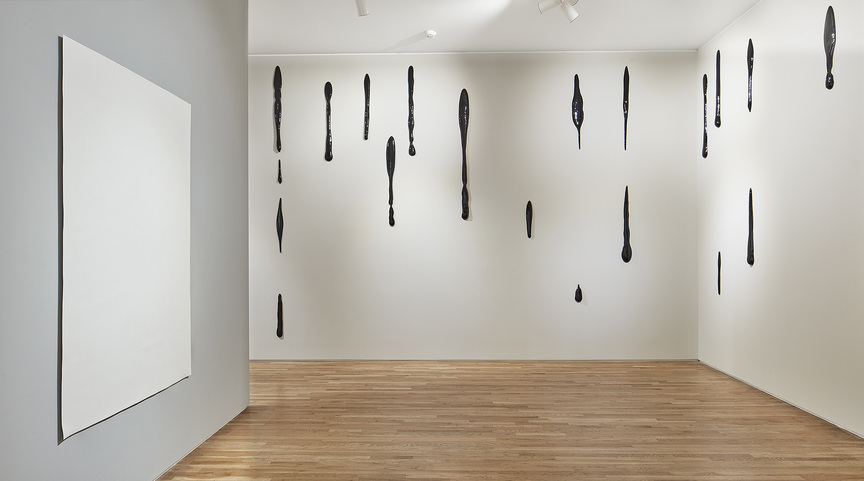-
From Current Issue
-
- Editor’s Letter Fire in the Heart
- Reviews I Gusti Ayu Kadek Murniasih
- Reviews 11th Seoul Mediacity Biennale: “One Escape at a Time”
- Dispatch Networked China
- One on One Monira Al Qadiri on Yukio Mishima
- Essays The rise of independent art spaces in pandemic-era Shanghai
- Features Tuan Andrew Nguyen
- Table of Contents
- Web Exclusives
- Archive
- Subscribe

R
E
V N
E
X
T
Installation view of LIU JIANHUA’s solo exhibition at Pace Gallery, Palo Alto, 2019. All photos by Johnna Arnold. All images copyright the artist; courtesy the artist and Pace Gallery, New York / London / Hong Kong / Palo Alto / Seoul / Geneva.
Since the late-1970s, Liu Jianhua has skillfully advanced the rank of ceramics from its commonplace utilitarian applications, elevating it beyond any trace of functionality, by crafting pristine sculptural objects grounded in abstract and minimal forms. For his first solo exhibition at Pace Gallery, Palo Alto, Liu presented a thoughtfully orchestrated selection from three defining bodies of work, all in keeping with the artist’s minimalist approach.
Upon entering the main gallery viewers encounter Blank Paper (2009–16), a rectangular ceramic work that hangs seemingly afloat on a freestanding wall in the middle of the space. An identical work from this signature series is installed on the back side of the same wall. Deceptively simple, with flat, matte surfaces, and free of any imagery, these seamless porcelain sheets, each measuring two meters high and over a meter wide, exhibit the hallmarks that attest to the precision and rigor of Liu’s practice. The only evident gesture or appearance of the artist’s hand can be seen in the slightly curled corners at the bottom of each empty page. Surrounding the two Blank Paper works were some 45 individual bas-relief elements from the series Trace (2011). These were inspired by ancient Chinese calligraphic brushstrokes known as wo lu hen, which, according to the gallery’s press materials, can be translated as “traces from a leaking roof.” Like gleaming black ink drops seeping through the gallery walls, these bulging, slug-like forms, ranging from more than a meter long to a mere two-and-a-half centimeters in the smallest one, return the idea of the brushstroke to its architectural reference while suggesting an unarticulated, fragmented language, absent of meaning or content, permeating the entire room. Cleverly paired with the Blank Paper works (though some might consider the juxtaposition overtly didactic), Trace created an immersive installation that carried the gallery’s somewhat modest 180-square-meter space.
Finally, isolated from the main exhibition area, selections from Liu’s series Square (2014) were displayed as five individual floor works. A more ambitious iteration of this series was featured in “Viva Arte Viva”at the 57th Venice Biennale in 2017. Shimmering like gold-glazed pools of water, or inert, static bubbles, arranged in seemingly random groupings on sheets of black steel, Square makes for an effective visual illusion, at once giving the appearance of liquefied precious metal—a kind of trompe l’oeil alchemy, so to speak—further exemplifying Liu’s cutting-edge command over the fragility of his materials.
Suffusing Liu’s exhibition was the prevailing ethos of mid-1970s Minimalism and Post-Minimalism, movements that considered the production of the artwork more vital than the resulting object and its relationship to its context. Liu’s own context comes from the ground itself: earthenware fashioned as a medium for his cultural interrogation of the notions of value and production. For Liu and other artists of his generation, concerns about globalization, fast-track economics, and social changes—all of which have literally and figuratively reshaped an entire nation—have also had an impact on their experimental modes of expression.
Beginning his career as an apprentice in the Jingdezhen Pottery and Porcelain Sculpture Factory—which, founded 1,700 years ago, remains the oldest center of ceramic production in China’s Jiangxi province—Liu’s transformative approach to one of sculpture’s most basic, fundamental materials continues to pose questions about China’s cultural heritage and its legacies in contemporary art. And despite the conspicuous elegance of this work, Liu continues to push the boundaries of what’s possible.
Arthur Solway is ArtAsiaPacific’s Shanghai desk editor.
Liu Jianhua’s solo exhibition is on view at Pace Gallery, Palo Alto, until August 4, 2019.
To read more of ArtAsiaPacific’s articles, visit our Digital Library.



















